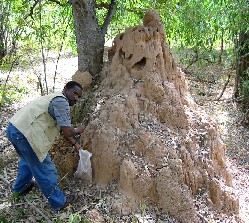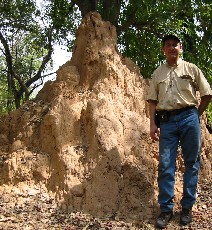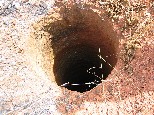If you recall RSG Geologists used Termite Mound sampling techniques so identify drill targets.
Article.
Termites and humans searching more gold in Mali
 |
Termite mounds are a preferred site for initial gold prospecting. Here, Malian geologist Ambogo Guindo, Vice President at North Atlantic Nickel, is taking samples from a termite mound in southern Mali. |
|
© afrol News/North Atlantic Nickel |
afrol News, 10 November - Aided by unconventional techniques, more and more gold deposits are found in southern Mali. The Canadian company North Atlantic Nickel is using the labour of termites to discover gold in the harsh condition of these Malian outskirts, making considerable successes. Jon North, President of the mining company, today announced the preliminary results of the mapping of the 219 square km Dalakan and 250 square km Sinzeni properties in southern Mali, which just have been completed. On both properties, soil and termite mound sampling had been the methods used.
At the Dalakan property, where the company has collected samples since June 2002, gold anomalies up to 6 km long have so far been found. To improve the mapping of the property, the company however had taken 2,536 soil samples and 226 termite mound samples during the last month. Especially the termite mounds had led the geologists to find five unknown areas of ancient artisanal workings, promising well for the future of the Dalakan property.
The Sinzeni property, on the other hand, has not been previously surveyed. 970 soil samples and 353 termite mound samples were collected as an initial survey of the property. Also here, three areas of artisanal workings were discovered, two of which are associated with gold anomalies in soil and termite mound samples.
At these initial stages of gold prospering, the unconventional "termite method" thus has proven rather successful for the Canadian company. Its advantages are obvious; there is less need for manpower and equipment, which has to be transported to these remote areas, when the work is left to the termites.
In a potentially gold rich area, termite mounds are isolated, dug up and analysed for gold or other precious particles. Termite mounds are only the visible top end of a large "mining system" made by this army of insects, digging to great depths in search of roots and ground water.
The industrious termites, while digging their tunnels, transport the hardest particles to the top layer of the soil, where materials are more easily sampled. Thus, an analysis of the termite mounds can give a quick answer to
 |
Canadian geologist Jon North, President of North Atlantic Nickel, is posing next to a termite mound in southern Mali, which is to become a sample for his company. |
|
© afrol News/North Atlantic Nickel |
the contents of deeper laying levels of soil and even rock.
- As opposed to simply taking surface soil samples, termite mounds allows us to get samples of very deep underlying soils, which would normally only be accessible via drilling or trenching, explains Nathalie Roy of North Atlantic Nickel. "Termites will dig down to the water table and that can be very, very deep," she adds.
The termite mounds serve as early indication as to what may be found in the soil below but the termites actually bring up mineral grains from down below the topsoil and hard laterite in what's called saprolite which is disaggregated bedrock, Ms Roy explains afrol News. "They dig to the water table or the colony dies, and the water table can be 10's of meters below surface but is generally about 10 meters below surface." They cannot go through bedrock, however.
In areas such as southern Mali, where the topsoil only gives few clues to the layers below, the 'termite mound technique' is a common sampling method and especially preferred. Here, the alternative for initial mapping would be outcrop sampling, float examination and tracing known faults - covered by layers of soil that often have arrived from far away by wind or water. The mounds, however, are everywhere in the terrain and sampling and analysing is cheap, about US$ 20.00 per sample, according to Ms Roy.
The technique is of old age in West Africa, where generations of gold diggers in pre-colonial times used the termites' labour to investigate the deeper layers of the soil for gold and other precious metals and minerals. The modern mining industry rediscovered the method in the 1960s, taking samples from termite mounds in the tropics and from anthills in other regions.
Reinventing this ancient and cheap method, the Vila Manica copper deposit in Mozambique were discovered in 1973. Later, the biggest kimberli
 |
North Atlantic Nickel is doing intensive mapping of potential gold deposits in southern Mali, both by digging in termite mounds and by conventional drilling. |
|
© afrol News/North Atlantic Nickel |
te (diamond) mine in the world - Jaweng in Botswana - was found by termite mound sampling. Several gold prospects in Southern Africa have since been discovered through the termite method, and a new science, termed "geozoology" has even been established to further develop the technique.
For North Atlantic Nickel's Mali operations, the reinvented method going scientific has already made operations more sustainable. In the remote areas of southern Mali, poorly connected to the main infrastructure of the region, such cheap methods can mean the exploration or non-exploration of the many promising gold fields of the area.
North Atlantic Nickel is especially keen on using "those little termites 'gold diggers'" for its own purposes in Mali. The company's President Jon North, who also is a geologist, on his own was able to observe the insects' tremendous work when he "picked up 1/2 g Gold from a termite mound sample collected at our Kantela property in western Mali," Ms Roy tells afrol News.
The Canadian company, although it still has to analyse the results of its newest soil samples and termite mound samples, has already been able to announce the finding of good indicators, such as several ancient areas of artisanal workings, on its two properties.
If the areas collected samples - which are to be sent to a Malian laboratory for analyses - prove promising, further mapping will be made at Dalakan and Sinzeni. Then, geologists will know where exactly to conduct more detailed studies. Conventional detailed mapping of the anomalous areas, additional soil sampling at higher density and ground magnetometer surveying are already planned to go ahead early next year.
Meanwhile, the enterprising termites of the southern savannas of Mali are left alone to make their own enquiries into the region's soil conditions - only to share them with future geologists.
By staff writer
© afrol News




